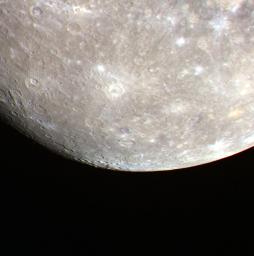
|
A Disappearing World
- Click the image above for a larger view
- Full-Res JPEG (508 x 512) (27.9 kB)
- Full-Res TIFF (508 x 512) (781.3 kB)
Caption:
The terminator , the division between night and day, is not as obvious in this image as in some others , but it can be seen on the bottom left portion of the planet in this image. This bottom left edge of Mercury appears to fade away, in contrast to the sunlit limb of the bottom right edge. The terrain near the terminator is heavily shadowed, and some of the neighboring surface is in the darkness of Mercury's night.
Date acquired:
June 27, 2011
Image Mission Elapsed Time (MET):
217686237, 217686239, 217686245
Image ID:
433696, 433697, 433701
Instrument:
Wide Angle Camera (WAC) of the Mercury Dual Imaging System (MDIS)
WAC filter:
9 (996 nanometers), 7 (748 nanometers), 6 (433 nanometers) as red, green, blue
Center Latitude:
-21.98°
Center Longitude:
234.5° E
Resolution:
4128 meters/pixel
Scale:
The radius of Mercury is approximately 2440 km (1520 miles)
Background Info:
The MESSENGER spacecraft is the first ever to orbit the planet Mercury, and the spacecraft's seven scientific instruments and radio science investigation are unraveling the history and evolution of the Solar System's innermost planet. Visit the Why Mercury? section of this website to learn more about the key science questions that the MESSENGER mission is addressing. During the one-year primary mission, MDIS is scheduled to acquire more than 75,000 images in support of MESSENGER's science goals.
These images are from MESSENGER, a NASA Discovery mission to conduct the first orbital study of the innermost planet, Mercury. For information regarding the use of images, see the MESSENGER image use policy .
Cataloging Keywords:
| Name | Value | Additional Values |
|---|---|---|
| Target | Mercury | |
| System | ||
| Target Type | Planet | |
| Mission | MESSENGER | |
| Instrument Host | MESSENGER | |
| Host Type | Orbiter | |
| Instrument | Mercury Dual Imaging System (MDIS) | |
| Detector | Wide Angle Camera (WAC) | |
| Extra Keywords | Color, Radio, Shadow | |
| Acquisition Date | ||
| Release Date | 2011-07-27 | |
| Date in Caption | 2011-06-27 | |
| Image Credit | NASA/Johns Hopkins University Applied Physics Laboratory/Carnegie Institution of Washington | |
| Source | photojournal.jpl.nasa.gov/catalog/PIA14496 | |
| Identifier | PIA14496 | |
